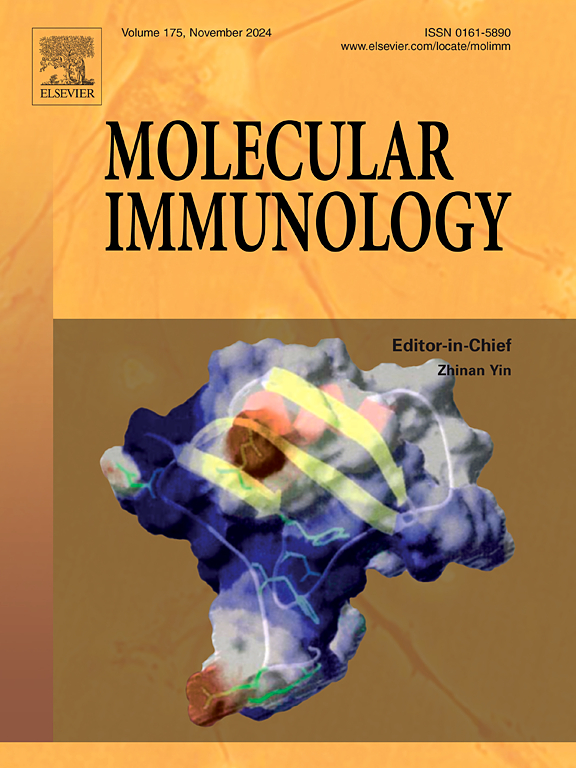nsun3介导的m5C修饰TAK1通过调节炎症促进败血症诱导的肺损伤
IF 3
3区 医学
Q2 BIOCHEMISTRY & MOLECULAR BIOLOGY
引用次数: 0
摘要
脓毒症引起的肺损伤(SPI)是一种危及生命的疾病,死亡率高。本研究旨在探讨NOP2/Sun RNA甲基转移酶3 (NSUN3)在SPI中的作用及其潜在机制。方法对GSE10474数据集进行生物信息学分析,揭示急性肺损伤中差异表达的基因。建立盲肠结扎穿刺(CLP)大鼠模型。苏木精和伊红(H&;E)染色评价肺损伤。采用酶联免疫吸附试验(ELISA)和逆转录-定量聚合酶链反应(RT-qPCR)检测炎症细胞因子mRNA表达和蛋白水平。在体外,用脂多糖处理人肺微血管内皮细胞(HULEC-5a),并用nsun3沉默或tak1过表达载体转染。通过甲基化RNA免疫沉淀(MeRIP)和双荧光素酶测定来研究NSUN3与转化生长因子β-活化激酶1 (TAK1)之间的相互作用。结果snsun3在clp诱导的大鼠肺组织和lps刺激的HULEC-5a细胞中表达上调。NSUN3抑制减轻了两种模型的肺损伤,降低了炎症细胞因子水平。机制上,nsun3介导的m -5修饰增强了HULEC-5a细胞中TAK1 mRNA的稳定性。TAK1过表达抵消了NSUN3敲低诱导的抗炎作用。结论nsun3介导的m5C修饰TAK1通过调节炎症促进SPI,为SPI的治疗提供了新的思路。本文章由计算机程序翻译,如有差异,请以英文原文为准。
NSUN3-mediated m5C modification of TAK1 promotes sepsis-induced pulmonary injury through regulating inflammation
Background
Sepsis-induced pulmonary injury (SPI) is a life-threatening condition with high mortality. This study aimed to investigate the role of NOP2/Sun RNA methyltransferase 3 (NSUN3) in SPI and its underlying mechanisms.
Methods
Bioinformatics analysis of the GSE10474 dataset revealed differentially expressed genes in acute lung injury. A cecum ligation and puncture (CLP) rat model was established. Lung injury was evaluated via hematoxylin and eosin (H&E) staining. Enzyme-linked immunosorbent assay (ELISA) and reverse transcription-quantitative polymerase chain reaction (RT-qPCR) were used to detect inflammatory cytokine mRNA expression and protein levels. In vitro, human lung microvascular endothelial cells (HULEC-5a) were treated with lipopolysaccharide and transfected with NSUN3-silencing or TAK1-overexpression vectors. Methylated RNA immunoprecipitation (MeRIP) and dual-luciferase assays were conducted to investigate the interactions between NSUN3 and transforming growth factor β-activated kinase 1 (TAK1).
Results
NSUN3 expression was upregulated in CLP-induced rat lung tissues and LPS-stimulated HULEC-5a cells. NSUN3 inhibition attenuated lung injury and decreased inflammatory cytokine levels in both models. Mechanistically, NSUN3-mediated m⁵C modification enhanced TAK1 mRNA stability in HULEC-5a cells. TAK1 overexpression counteracted the anti-inflammatory effects induced by NSUN3 knockdown.
Conclusion
NSUN3-mediated m5C modification of TAK1 promoted SPI through regulating inflammation, providing a new insight for SPI treatment.
求助全文
通过发布文献求助,成功后即可免费获取论文全文。
去求助
来源期刊

Molecular immunology
医学-免疫学
CiteScore
6.90
自引率
2.80%
发文量
324
审稿时长
50 days
期刊介绍:
Molecular Immunology publishes original articles, reviews and commentaries on all areas of immunology, with a particular focus on description of cellular, biochemical or genetic mechanisms underlying immunological phenomena. Studies on all model organisms, from invertebrates to humans, are suitable. Examples include, but are not restricted to:
Infection, autoimmunity, transplantation, immunodeficiencies, inflammation and tumor immunology
Mechanisms of induction, regulation and termination of innate and adaptive immunity
Intercellular communication, cooperation and regulation
Intracellular mechanisms of immunity (endocytosis, protein trafficking, pathogen recognition, antigen presentation, etc)
Mechanisms of action of the cells and molecules of the immune system
Structural analysis
Development of the immune system
Comparative immunology and evolution of the immune system
"Omics" studies and bioinformatics
Vaccines, biotechnology and therapeutic manipulation of the immune system (therapeutic antibodies, cytokines, cellular therapies, etc)
Technical developments.
 求助内容:
求助内容: 应助结果提醒方式:
应助结果提醒方式:


